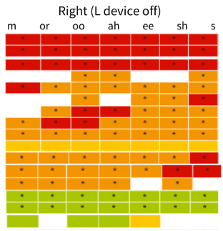Hearing loss can have a profound impact on a child’s life. For children developing listening and spoken communication skills, it can impact on their ability to develop these skills in the same way as their typically hearing peers. Early diagnosis and intervention are essential for ensuring children with hearing loss can develop listening and spoken communication skills from an early age.
The Shepherd Centre has developed two tools that have been instrumental in achieving better outcomes for children with hearing loss: the Functional Listening Index-Paediatric (FLI-P®) and the Rapid Evaluation and Documentation of Detection and Imitation (REDDI).
In this blog, we’ll use the real-life experience of Maribella and her family to explore how the FLI-P® and REDDI tools can help improve outcomes for children with hearing loss.
Meet Maribella
Meet Maribella. For many years, Maribella’s family was told that Maribella’s hearing loss wasn’t severe enough to require cochlear implants. Maribella used hearing aids to help her to hear the sounds of speech and sounds in her environment. The family did all the right things to help her. They made sure Maribella always wore her hearing aids and were actively engaged in her learning. Despite this, it was apparent Maribella still wasn’t accessing all the sounds of speech and her speech development wasn’t progressing as expected.
Knowing there was a critical piece of the puzzle missing from their daughter’s care plan, the family contacted The Shepherd Centre. This was where Maribella was assessed to understand her functional access to sound. This was done using the REDDI tool. After assessing and monitoring Maribella’s functional access to sound over a period of time using the REDDI tool, the family could see just how difficult it was for Maribella to detect speech information important for Maribella to develop her speech and language skills.
The first image shows Maribella’s responses to the Ling sounds tracked using the REDDI tool.

- Red rectangles indicate no detection of the speech sound, while orange rectangles indicate detection of sound when increased listening cues are applied (e.g. volume raised, intonation added or increased length of sound). The orange and red responses reflect Maribella’s listening responses with her hearing aid.
- Green rectangles show detection of speech sounds. Green emerged in the REDDI visualisation graph when Maribella received her first cochlear implant on her right side. The traffic light visualisation of the REDDI helped inform the clinical discussion and decision making with Maribella’s family, as it was evident her listening, speech, or language weren’t progressing.
Despite Maribella’s family being told for many years that her hearing loss wasn’t severe enough to need cochlear implants, the REDDI tool helped the family visually see their daughter’s inability to detect frequency specific speech sound information. This then helped to inform the clinical direction of undergoing cochlear implant evaluation and discussion on the likely benefit that receiving cochlear implants might bring to Maribella.
The second picture shows Maribella’s responses to sound after listening with her right cochlear implant over a period of 12 months.

- Maribella could imitate all the speech sounds tracked in the REDDI tool from increasing distances. The darker green colour shows Maribella imitating speech sounds from five metres and the orange colour shows her imitating sounds with increased listening cues.
When Maribella requires increased listening cues, her hearing team troubleshoot with Maribella to help her access sound. They check that her cochlear implant coil cable is working, that her cochlear implant speech processor microphone covers have been changed, and that her cochlear implant is functioning correctly overall.
In addition to the technical troubleshooting, they also check in with her overall well-being to gauge if any situation outside of her hearing is impacting her ability to respond to the sounds being presented in the functional listening check.
Maribella’s family and her hearing team love seeing an increasing number of green responses appear in her vidualisation graph for the REDDI. It provides Maribella and her family the confidence to trust what she is hearing and to help problem solve if the need arises.
Maribella went on to receive a second cochlear implant for her left ear. Her family happily shared with us that Maribella is a completely different child after receiving two cochlear implants. She is confident, outspoken, and super responsive to what she hears. As demonstrated through Maribella’s experience, the REDDI tool plays a critical role in assessing a child’s functional hearing and access to sound through an easy-to-interpret visual chart. This then provides clear evidence to support whether a child has sufficient access to sound in order to develop listening and spoken communication skills.
If you want to learn more about how our FLI-P® and REDDI tools can help you with your clinical decision-making, book a 30-minute session with our friendly team today.
HearHub subscriptions are also available and can be operating in just 48 business hours. View our subscription plans.


